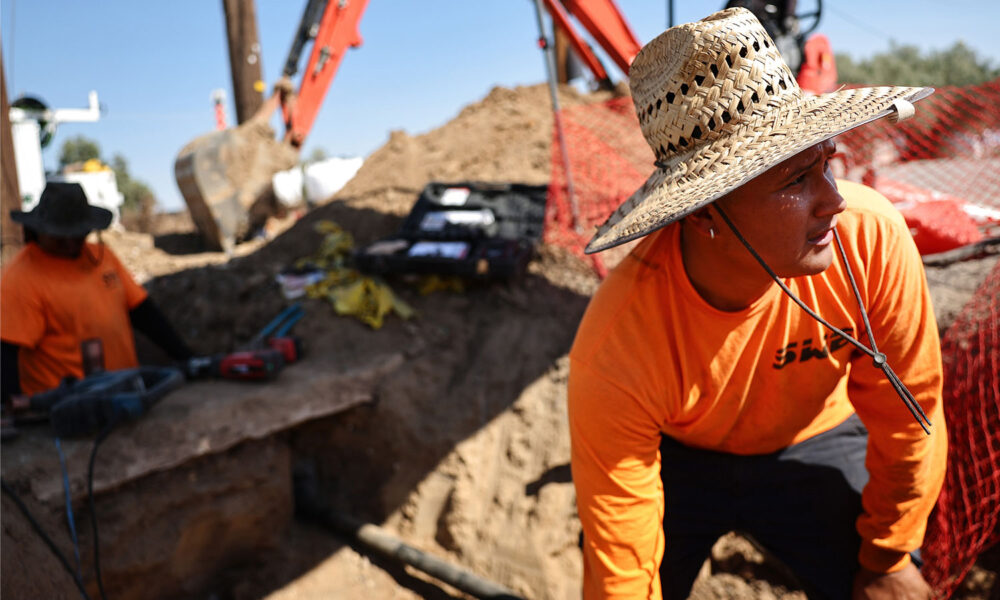It’s November, and heat may not be the first thing on your mind. But here’s why it should be and what you can do to help indoor and outdoor workers stay safe from deadly heat. The Occupational Safety and Health Administration (OSHA) has issued a proposed heat health safety standard and is taking comments on it through the end of December. Please weigh in to protect workers’ health and safety.
We’re coming off a summer that was the planet’s hottest on record, and millions of people had to work through it in conditions that are risky for their health—even deadly. Many of us interact frequently with outdoor workers or have friends and family who work outdoors. They work construction jobs, or harvest vegetables and fruit, handle baggage on hot airport tarmacs, clean the inside of planes with the AC turned off in between flights, or deliver packages to our doorsteps. In the United States, outdoor workers face a disproportionate risk of heat-related death, which occurs disproportionately among Black and Hispanic people.
Even now, with fall in the air, we are reminded of the harsh reality that fossil-fueled climate change is causing fall to be warmer across the contiguous US, particularly in the southwest. Phoenix, which has experienced record-breaking extended heatwaves this year, endured an unprecedented four days of temperatures of 110°F or higher in October! California too experienced a late-season October heatwave, made worse by climate change. And the first few weeks in November had weirdly warm temperatures across the Northeast.
The National Oceanic and Atmospheric Administration’s (NOAA) monthly outlook for October and November looks to follow this trend in which many parts of the US will have above-average temperatures. Warmer temperatures during the fall months could have repercussions on outdoor workers who worked through dangerously hot conditions this past summer.
Our own research finds that outdoor workers’ exposure to extreme heat can be expected to triple or quadruple between now and midcentury depending on the pace of growth in global heat-trapping emissions. As if this projected increase in extreme heat exposure isn’t daunting enough, outdoor workers are also at risk of collectively losing up to $55.4 billion in annual earnings due to extreme heat.
Is there any good news?
Yes! After years and even decades of calls for action, OSHA has finally proposed heat protection standards to help keep workers safe, and we have an opportunity to urge them to quickly finalize the strongest version of these standards.
On July 2, 2024 OSHA announced the release of the Heat Injury and Illness Prevention in Outdoor and Indoor Work Settings rulemaking and on August 30 OSHA officially listed the proposed rule in the Federal Register, requesting public comments by December 30, 2024.
What it does
OSHA’s goal is to prevent and reduce the number of occupational injuries, illnesses, and fatalities caused by exposure to hazardous heat. It would apply to all employers whose workers take part in outdoor and indoor work across industries and in construction, maritime, and agriculture sectors where OSHA has jurisdiction, excluding emergency responders and people working in air-conditioned spaces.
OSHA’s standard would require employers to create a plan to evaluate and control heat hazards in their workplace and would clarify employer obligations and the steps necessary to effectively protect employees from hazardous heat.
OSHA has also provided a robust and extensive scientific basis for the rule. Section III of the proposed rule provides these science-based background materials, and OSHA also has a one-stop shop webpage with additional background information and resources.
Critical points for public comments
UCS, alongside a broad coalition of worker justice and public health professionals, has long been calling for these heat-health protections. We have also been weighing in on the OSHA rulemaking process over the years (2022 and 2023).
We hope that you will submit comments in support of OSHA’s rulemaking.
In a recent blogpost, my former colleague Kristina Dahl summarized the proposed rulemaking, noting that while there are areas for improvement that OSHA should address, this is a strong standard that will help keep workers safer from extreme heat.
As you prepare to submit comments on OSHA’s heat standard, below are points from Kristy Dahl’s overview to keep in mind:
1. Support the strong provisions in the heat protection standard which include:
- The core health-protective measures workers need when it’s hot: water, shade, and rest;
- Provisions that require rest breaks to be paid—a real win that will ensure workers don’t have to choose between their health and their livelihoods. UCS research shows that outdoor workers could collectively be losing billions of dollars in earnings due to worsening extreme heat by midcentury if provisions like this are not in place;
- The inclusion of an initial heat trigger at 80°F, above which certain protective measures go into place, and a high heat trigger at 90°F, when those measures get ramped up;
- Requirements that managers involve non-managerial employees in identifying hot spots in workplaces and in developing plans to monitor employees when it’s hot.
2. Highlight how the standard could be improved:
- Written heat injury and illness protection plans should not be exempted for employers with fewer than 10 employers. There are different means of assessing how many employers and employees this would exempt, but it’s safe to say it’s a lot. Pew Research shows that half of small businesses in the US have fewer than five employees, for example. And the Small Business & Entrepreneurship Council has used Census data to estimate that nearly 80% of employer firms have fewer than ten employees.
- OSHA should strengthen protections for temporary and part-time workers, many of whom work in construction and agriculture, as recommended by heat and health experts like Juanita Constible.
- Weak and limited recordkeeping requirements. Under the proposed rule, employers would not be required to keep records of heat illnesses and injuries experienced in their workplaces or how those cases were resolved. Employers would only be required to keep six months’ worth of records of workplace temperatures.
- Fixed length for rest breaks. The rest break policy is set at a minimum of 15 minutes every two hours rather than progressively longer breaks as the temperature rises, as was suggested by the Centers for Disease Control and Prevention (CDC) in their 2016 recommendations.
- Shorter-than-needed acclimatization periods. The proposed rule requires employers to implement a gradual period of acclimatization for new workers that is, at a minimum, four days long. Science suggests this is much too short. OSHA’s own data has shown that most workplace heat-related fatalities occur during the first week on the job. And the CDC notes that acclimatization can take longer than one week.
- Improve sedentary work activity protections. We are pleased OSHA included more specificity on what constitutes sedentary work indoors and encourage OSHA to maintain, at a minimum, this language. However, workers’ exposure to sufficiently extreme heat even when sedentary can present serious harms. Given this, we encourage OSHA to consider a stipulation in which the standard does not apply to those engaged in sedentary work activities in environments where the heat index is below 110 °F but does apply in environments above that threshold.
- Monitoring conditions at work sites or with local forecasts. This policy has the potential to provide insufficient protection for workers because measurements from the weather stations used to determine forecasts might differ from measurements at local worksites. Instead, we recommend OSHA strengthen this policy by requiring employers to monitor the on-site heat index or wet bulb globe temperature throughout the day. Alternatively, employers could note that if the daily maximum heat index forecast exceeds relevant thresholds, they would then implement protection measures for the full workday regardless of how temperature and humidity evolve throughout the day.
If you have expertise on worker conditions, public health or if you’re simply interested in submitting a more substantial set of comments you may be interested in reading and lending support to our full set of UCS comments on the heat protection standard. You could also draw from fellow advocate Juanita Constible’s excellent blog post about the proposed rule and this recent helpful NPR interview with experts including Kristina Dahl. We also recommend that you read the proposed rule itself and decide how you’d like to respond. For even more in-depth data, you may wish to review UCS’s reports Killer Heat and Too Hot To Work.
Whatever route you choose, we urge you to consider submitting a comment. The health and wellbeing of the roughly 36 million outdoor and indoor workers in the U.S. depends on this standard being as strong as possible, and it’s up to all of us to ensure it lives up to its potential.
State and local protections to complement the OSHA standard
While we are very close to being able to celebrate a productive end to this long OSHA heat standard journey (since the 1970’s), there are still multiple stages in the rulemaking process that will take months or years to finalize so the work doesn’t stop here.
We also need state and local protection standards. Why you ask? Good question. Currently only a few states and localities have heat protection standards and even when we have a final federal standard, states and localities can do more to tailor their policies to better reflect local conditions and employee needs while also lending to an increase in monitoring and enforcement of these standards so that fewer workers are left to the mercy of their employer. For more on state and local policies, see Public Citizens Scorched States report card and Section III, Part D of the proposed rule.
With your help, we’ll get a strong and final federal rule requiring employers to implement OSHA’s heat-protection standard. Moving forward we will also work to advocate for strong state and local standards. Thank you for your efforts in helping to keep workers safe from dangerously hot working conditions!

